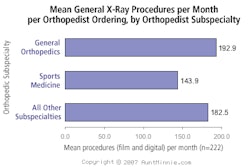This article originally appeared in the American Journal of Roentgenology, written by Dr. Howard Forman, associate editor of health policy for the American Roentgen Ray Society (ARRS).

In 2007, Medicare improved payments to evaluation and management (E&M) services. This welcome change helps to better compensate office visits, which have otherwise been poorly compensated for a long time. However, due to statutory requirements, Medicare required budget neutrality: Any improvement for payments in one area would yield budgetary reductions in another. For many specialties, the improvements in E&M payments more than offset any reductions in procedures. As is obvious, though, very little revenue in radiology flows from E&M codes, and, thus, the reductions are severe and challenging.
This reduction is worse than previous reductions for several reasons. First, this adjustment involved the actual relative value units (RVUs) assigned to each encounter. This change, as part of the budget neutrality measure, is permanent and not tied to the conversion factor. Medicare has basically readjusted the relative number of dollars that now flow to E&M codes versus procedures.
Second, Medicare has introduced legislation that will offer a small (1.5% annualized) bonus to physicians who can provide quality metrics (pay-for-performance or P4F) on their patients. In the case of direct clinical encounters, this is feasible -- even if it is difficult. In the case of radiology, it is impossible at the current time, as we do not have reliable metrics approved by the U.S. Centers for Medicare and Medicaid Services (CMS).
The physician quality measures offered by CMS have only a passing connection to radiology, making any current effort to achieve the bonus payment wasted. In the future, we may be able to generate true measures, but this is an uphill battle and one that is not yet in the front-and-center of most radiologists' practices.
If pay-for-performance measures take hold, they may represent yet another means of shifting more revenues toward clinical encounters and away from procedures. In most relevant ways, it is a good thing for patients, patient care, and the clinical specialties that have long been undercompensated. Nonetheless, it is a serious threat to our specialty, as it will likely reduce relative compensation, particularly from Medicare, and could result in reduced imaging access for the more than 40 million elderly and disabled who rely on this program for their healthcare.
Lastly, since this change affects the actual RVUs assigned to our procedures, any and all practices that negotiate contracts based on RVUs may ultimately receive lower reimbursement from private payors relative to other specialties. This last issue requires further explanation.
When Medicare has previously adjusted the conversion factor downward (only once in the last few years) or kept it flat, the effect on all physicians was equal. Furthermore, if a commercial payor was paying you $70 per RVU, any change in the Medicare conversion factor was not going to affect your managed care payments. Now, however, when your group renegotiates a contract, if the payment for RVU goes up by 5%, the net payment will still be going down, due to the budget neutrality adjustment to the underlying Medicare fee schedule. For those practices that are not using an RVU-based fee schedule, these changes will still likely seep into your reimbursement as managed care organizations do, ultimately, follow Medicare policies and directions, particularly when it can save them money.
These changes only apply to our professional reimbursement -- that is, the compensation for the interpretation of imaging studies. The Deficit Reduction Act (DRA) of 2005 also reduced compensation for our outpatient technical reimbursement, effective January 1, 2007.
What does all this mean for our specialty? In past policy briefs, I have shared some of my concerns, but I have never felt we were in real current danger -- until now. I think this year will not only be challenging, but could strain marginal practices. Many practices still have not experienced productivity gains that flow from teleradiology and the digital environment. They will be hard-pressed to initiate such changes in a declining revenue environment. Those practices that are already operating at their most efficient will survive, but expectations may need to be readjusted.
Hiring by practices may be curtailed in this current environment. Much as practices withheld hiring in the mid-1990s until they saw the full effect of managed care, academic and private practices may feel sufficient uncertainty to curtail new hiring, even in the climate of increased volume. Individual physicians, too, may feel better about working more rather than earning less. While the effects of managed care on utilization and pricing were never as severe as predicted, Medicare is a much bigger threat. Even efforts at retaining volume via successful turf wars may mean little if pricing is compromised substantially.
Perhaps one of the few positive effects that may come out of these changes will be a reduction in the overinvestment in medical imaging facilities by many of our clinical colleagues. If capacity does not increase substantially in the next few years, pricing power may increase and we may be in a better position to negotiate rates. The recent news that Minneapolis-based UnitedHealth Group will require facility accreditation for reimbursement of advanced imaging technologies is welcome and will result in better patient care. As well, it will almost certainly deter some clinicians from purchasing their own CT, PET, and MRI equipment.
On the other hand, a recent article in the Wall Street Journal ("Hospital Cuts Costs With Novel Plan," January 12, 2007) suggests that there is ample room for health plans to reduce imaging utilization and costs. Our practices should be wary, as well. Whether it is the private sector or Medicare, we clearly are a target for healthcare cost and/or utilization reduction.
In a future policy brief, I will again summarize the current state of U.S. healthcare and Medicare finance. Suffice it to say that the near future does not look rosy for radiology, and it will not improve until we take the lead in documenting our clinical value and quality measures.
By Dr. Howard Forman
AuntMinnie.com contributing writer
April 20, 2007
Dr. Forman is an associate editor of health policy for the American Roentgen Ray Society (ARRS). This article originally appeared in the American Journal of Roentgenology (April 2007, Vol. 188:4, pp. 889-890). Reprinted by permission of the ARRS.
The opinions expressed in this policy brief are those of Dr. Forman; they do not necessarily reflect the viewpoint or position of the American Roentgen Ray Society or AuntMinnie.com.
Related Reading
DRA's arrival forces imaging centers to adapt, February 1, 2007
The radiology job market: Help wanted, November 23, 2006
How to win the coronary CTA turf war, October 9, 2006
MRI and CT imaging: How fast can reimbursement be cut?, September 20, 2006
Radiology reimbursement faces major changes, August 21, 2006
Copyright © 2007 American Roentgen Ray Society



















